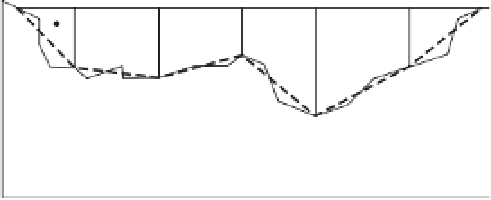Geoscience Reference
In-Depth Information
two important subsections: instantaneous and
continuous techniques.
Instantaneous streamflow
measurement
Velocity-area method
Figure 5.6
The velocity-area method of streamflow
measurement. The black circles indicate the position of
velocity readings. Dashed lines represent the triangular
or trapezoidal cross-sectional area through which the
velocity is measured.
Streamflow or discharge is a volume of water per
unit of time. The standard units for measurement
of discharge are m
3
/s (cubic metres per second or
cumecs
). If we rewrite the units of discharge we can
think of them as a water velocity (m/s) passing
through a cross-sectional area (m
2
). Therefore:
m
3
/s = m/s
m
2
(5.1)
The
velocity-area method
measures the stream
velocity, the stream cross-sectional area and multi-
plies the two together. In practice this is carried out
by dividing the stream into small sections and
measuring the velocity of flow going through each
cross-sectional area and applying equation 5.2.
Qva va
=++
11
K
v
ii
(5.2)
Figure 5.7
Flow gauging a small stream.
22
where
Q
is the streamflow or discharge (m
3
/s),
v
is
the velocity measured in each trapezoidal cross-
sectional area (see Figure 5.6), and
a
is the area of
the trapezoid (usually estimated as the average of
two depths divided by the width between).
The number of cross-sectional areas that are
used in a discharge measurement depend upon the
width and smoothness of stream bed. If the bed is
particularly rough it is necessary to use more cross-
sectional areas so that the estimates are as close to
reality as possible (note the discrepancy between the
broken and solid lines in Figure 5.6).
The water velocity measurement is usually taken
with a flow meter (Figure 5.7). This is a form of
propeller inserted into the stream which records the
number of propeller turns with time. This reading
can be easily converted into a stream velocity using
the calibration equation supplied with the flow
meter.
In the velocity-area method it is necessary to
assume that the velocity measurement is repre-
sentative of all the velocities throughout the cross-
sectional area. It is not normally possible to take
multiple measurements so an allowance has to be
made for the fact that the water travels faster along
the surface than nearer the stream bed. This
difference in velocity is due to friction exerted on
the water as it passes over the stream bed, slowing
it down. As a general rule of thumb the sampling
depth should be 60 per cent of the stream depth
- that is, in a stream that is 1 m deep the sampling
point should be 0.6 m below the surface or 0.4 m
above the bed. In a deep river it is good practice
to take two measurements (one at 20 per cent and









